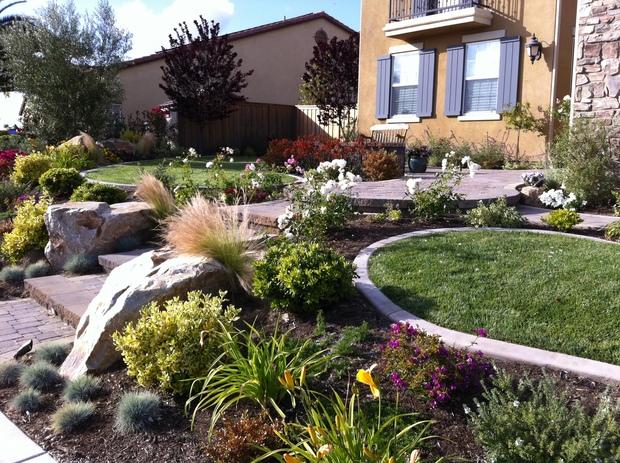Landscapers - The Facts
Landscapers - The Facts
Blog Article
8 Simple Techniques For Landscapers
Table of ContentsHow Landscapers can Save You Time, Stress, and Money.The Greatest Guide To LandscapersThe Best Guide To LandscapersThe smart Trick of Landscapers That Nobody is DiscussingLittle Known Questions About Landscapers.The 20-Second Trick For Landscapers
- A garden feature where water is stood for by an aggregate stone product, typically a crushed rock or granite.- A rock or natural flagstone patio, path, or walkway developed without a concrete base.- A rock preserving or totally free standing wall developed without the usage of mortar. A very proficient mason is required for a completely dry stack stone wall. The majority of walls in Portland are moist piled, also if they appear to be. - An underground structure that accumulate water and enables it to slow down percolate into the soil around it.
Landscape design that is suitable with a sites' environment in both look and sustainability without adverse effects to the environment. Bordering in the landscape is a line of demarcation that produces visual passion in the yard by separating one sector from an additional section.
Areas can likewise have a sensation of "unit" provided by trees, other plantings, fences, or displays. The landscape near the entry to a structure.
Not known Factual Statements About Landscapers

The element in a landscape design or location in a landscape that is meant to be most popular. The focal point can be a plant, boulder, sculpture, collecting area, or various other landscape attribute.

Little Known Questions About Landscapers.
Low plants that are enabled or motivated to spread out over a location. Can refer to any kind of "difficult" yard components consisting of statuary or boulders however the majority of typically is utilized to refer to courses, outdoor patios, and walls - Landscapers.: Elevation distinction in between the degree of water in a fish pond (or the degree of the pump if it rests outside the fish pond) and the upper outlet of water which impacts performance of the water pump in gph (gallons per hour).
A chemical utilized to manage weeds. Fencing boards that run flat, usually used in modern-day or Japanese-inspired landscape designs. Lines that define rooms within a landscape idea. These frequently expand from edges or key attributes of an existing structure. Proper use of imaginary lines can help the landscape feel connected to the home and other aspects.
Traditional PNW landscapes are casual. A plant that spreads out more than desired, or right into habitats where it does damage.
See This Report on Landscapers
Can consist of head placements and protection, pipeline sizing, GPM specs, and materials needed to mount this system. Certified specialist that designs landscapes, coached in design and architecture as well as in gardening.
The specialist that intends and develops landscape projects, normally at a domestic or little business degree with the significant layout inspiration on growings. Landscape developers typically have less schooling than Landscape important source Architects and are not licensed. A finished landscape layout, outlining all aspects for the brand-new landscape. This normally takes the type of an illustration on paper.
Calcium material made use of to raise the pH in dirt, which will certainly make it less congenial to moss (Landscapers). A water limited HDPE product utilized beneath ponds, streams and waterfalls in see here water attributes. Making use of several growings of the exact same range to complete a location in the landscape. This can decrease maintenance and water use in the yard.
A mix of concrete, sand, and water that is made use of in rock masonry for establishing stones and joints. A layer of compost or bark dirt applied at the base of a plant. A mass growing of moss. A plant that was existing in a geographical location prior to people began altering the landscape.
See This Report about Landscapers
Just how the garden or a garden element is prepared in relationship to an existing or brand-new attribute or to a direction. Keeping a grass without making use of chemical herbicides, chemicals, or plant foods. Turfs that are not trimmed but grown in landscapes as perennials. This is a partially open sided relaxation or entertainment area that joins a dwelling, made use of for amusing, outdoor dining and just taking pleasure in the exterior environment.

Tiny round crushed rock. Plants that supply seasonal rate of interest and after that pass away back in the wintertime. Annuals do not come back the following period, yet perennials do. Winter season yard that is one of the most typical turf yard in Rose city, OR and the rest of the PNW.An open roofed structure over an outdoor patio or other landscape feature.
Basalt accumulated varying in size from 1/4" to dust. One of the most typical landscape gravel in the PNW. Area of the landscape created to deal with rain water up until it can soak right into the ground. A chain that manages water as it takes a trip from a roof covering rain gutter to the web ground. Yard structure that develops a planting location that is consisted of and higher than the bordering quality.
Structure made of timber, concrete, paving stones, bricks or other materials for maintaining slopes and protecting against too much erosion. Slim gutter. Producing a yard feature being composed largely of stones with growings that complement and can flourish in the rough setting. Sprinkler head style that revolves a stream of water across an area.
The Landscapers Ideas

Report this page